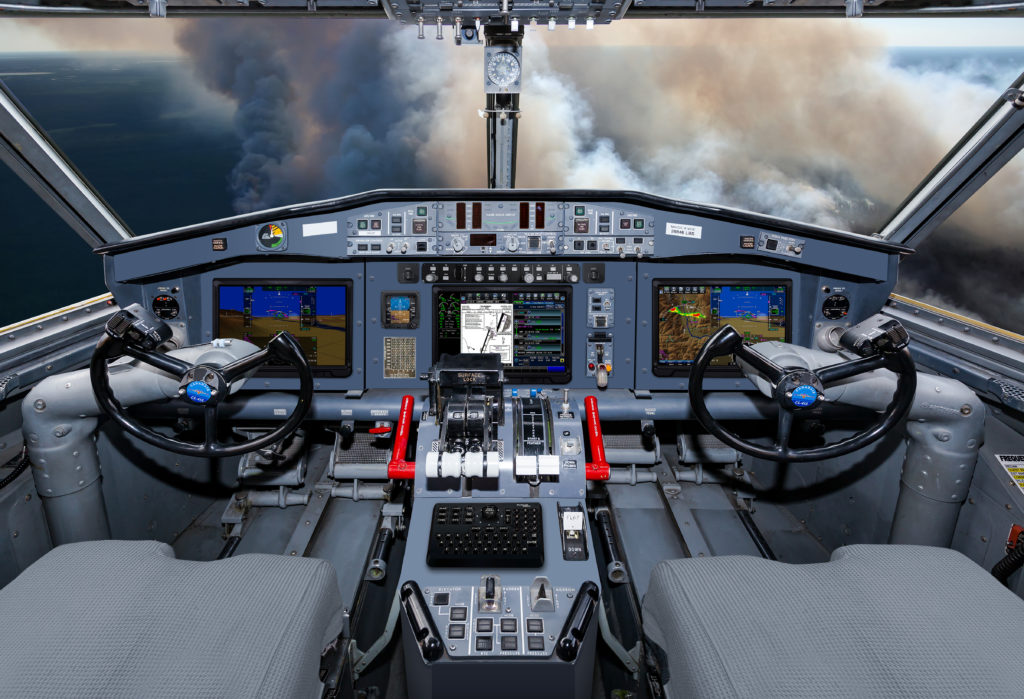Estimated reading time 7 minutes, 3 seconds.
Often referred to as the “SuperScooper,” the Canadair CL-415 and its older sibling, the CL-215, are known around the world for their aerial firefighting capabilities.

First introduced in 1967 by Canadair, the original CL-215 had piston engines. When Bombardier bought the company in 1986 and obtained the type certificate for the aerial firefighter, it spearheaded a turbine engine conversion in 1989 and named it the CL-215T. Subsequently, the manufacturer developed the turbine-powered CL-415 in the 1990s.
The amphibious aircraft are capable of scooping just over 6,000 litres from a body of water within 12 seconds. After flying to a fire, the aircraft drop their loads and return to the water source to do it all over again.
There are just under 170 Canadair amphibious firefighting aircraft flying worldwide, and while each may only log 200 to 300 flight hours annually, their missions are demanding.
The airspace around a wildfire is busy with limited visibility, and it’s crucial for waterbombers to see and be seen. On any given mission, they may be flying in concert with other resources deployed to fight a fire, which could include tankers carrying fire retardant, helicopters slinging water in Bambi buckets, and Bird Dog aircraft overseeing the entire operation.
As the original CL-215T and CL-415 aircraft age, their outdated avionics are posing a significant challenge. In a world implementing technology such as ADS-B Out and controller pilot data link communications (CPDLC), the CL-215T and 415 family is becoming obsolete.
A good start
Viking Air Ltd. of Sidney, B.C., which obtained the Canadair amphibious aircraft type certificates from Bombardier in 2016 and now supports the worldwide fleet, is working to address this problem with a cockpit upgrade. It will enable the legendary aerial firefighters to fly in any airspace and is expected to extend their service lives by 25 years.
“This aircraft has had a long life and a long history,” said Dan Seroussi, director, Programs at Viking. “The design originated in the 1960s with a piston engine. When we took over the program, we wanted to provide our operators with an evolution to give them more service life and a better dispatchability. We wanted to have a good start and immediately show our commitment to the aircraft and to our operator group.”
So, Viking asked CL-215T and CL-415 operators about the biggest challenges faced by their fleets.
“It was obsolescence,” explained Seroussi. “They came to us with a lot of issues which led to a focus on the avionics. It was an opportunity to extend the life of the existing fleet.

“New requirements are mandatory, such as ADS-B Out,” he continued. “On top of that, the technology has evolved. Even if it’s not mandatory, more modern technology is available to help this aircraft accomplish its mission. We wanted to take this opportunity to upgrade the avionics suite and improve performance wherever possible.”
The result is the Avionics Upgrade Program (AUP) for the Canadair CL-215T and CL-415 aircraft, launched in May 2019. Viking selected fellow B.C.-based company, Cascade Aerospace of Abbotsford, to perform the integration of a new Collins Aerospace Pro Line Fusion avionics suite with embedded display system.
“Cascade defines the requirements and manages the design and certification activities,” explained Seroussi. “They will install and certify the upgraded avionics and as the aircraft OEM, Viking will integrate the modification into the type certificate of the CL platform.”
The design of the modification is currently under development and is nearing the preliminary design review stage. The first CL-415 to undergo the modification process will be used as the prototype and is expected to be completed “with all the options” and certified by the end of 2021.
Seroussi reported good progress so far, adding it will take approximately 6,000 hours of work to complete subsequent installations, after program certification and learning curve amortization is taken into account. He estimated the potential market for this avionics upgrade could exceed 100 aircraft worldwide.
“The Pro Line Fusion avionics suite is well suited to this application because of its software-enabled scalability and flexible architecture,” he said. “We will start with one standard cockpit layout optimized for the 415, then we will try to familiarize the upgraded cockpit for the CL-215T as much as possible.”
The baseline (core) configuration of the avionics suite will include all of the required avionics capabilities, including (but not limited to) flight director, engine hydraulic, surface control, communication and crew alerting system indications on the displays, flight management system (FMS) coupled with SBAS-GPS providing LPV capability, mutable terrain awareness warning system (TAWS), traffic collision avoidance system (TCAS) II 7.1, ADS-B Out, synthetic vision, night vision imaging system compatibility, enhanced mapping, AirNav maps, voice radio, navaids systems, and a multi-function keyboard panel along with two cursor controls that provide a fully equivalent alternative to the touchscreen commands.
Autopilot, flight monitoring system, weather radar, satcom, flight data recorder or datalink are a few of the numerous options that can be incorporated based on each operator’s requirements.
The cockpit upgrade will cost less than the alternative of incorporating three individual upgrade STCs, with each only providing one of the many new functionalities now included in the AUP core configuration.
So far, there has been “significant interest” from the aerial firefighting community, and Seroussi expects that to increase once the first aircraft has been completed. He told Skies that Viking is also close to finalizing arrangements with the avionics upgrade program’s CL-415 launch customer.
While the work proceeds, Seroussi said Viking is also likely to utilize the advancements made in the AUP as the basis for a proposed CL-415 replacement, called the CL-515.








